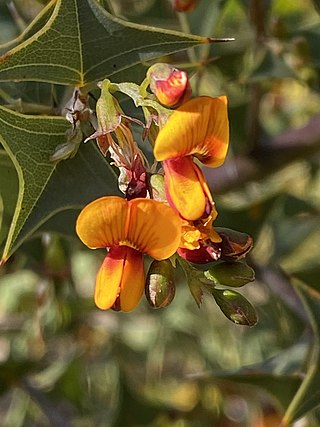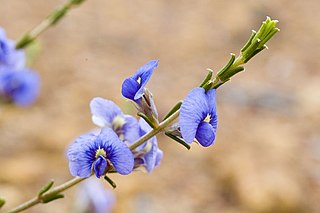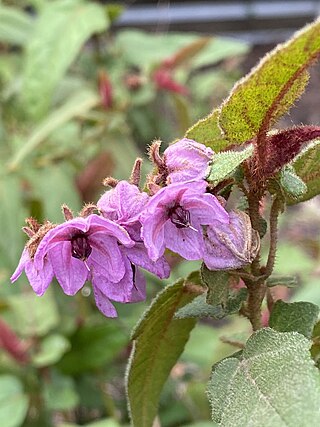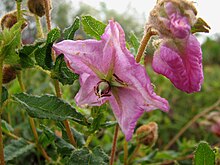
Thomasia is a genus of thirty-one species of flowering plants in the family Malvaceae. Plants in this genus are small shrubs that are endemic to the south-west of Western Australia, apart from T. petalocalyx that is native to Victoria and South Australia. The leaves are simple with leaf-like stipules at the base of the petiole, the flowers bisexual with five papery, petal-like sepals, usually five petals and five stamens opposite the petals. The fruit is a capsule covered with star-like hairs.

Lechenaultia biloba, commonly known as blue leschenaultia, is a species of flowering plant in the family Goodeniaceae and is endemic to the south-west of Western Australia. It is a glabrous herb or subshrub with spreading branches, almost no leaves, and yellow, tube-shaped flowers.

Thomasia purpurea is a small, flowering shrub in the family Malvaceae that is endemic to the southwest of Western Australia. It has green oblong-shaped leaves and pinkish purple flowers.

Thomasia macrocarpa, commonly known as large-fruited thomasia, is a shrub that is endemic to the southwest of Western Australia.

Guichenotia macrantha, commonly known as large-flowered guichenotia, is a species of flowering plant in the family Malvaceae. It is a shrub with grey-green leaves, mauve flowers and is endemic to Western Australia.

Verticordia densiflora, commonly known as compacted featherflower, is a flowering plant in the myrtle family, Myrtaceae and is endemic to the south-west of Western Australia. It is a shrub with small leaves, usually small pink and white flowers and which is widespread in the south-west of the state. It is a variable species and in his 1991 paper, Alex George formally described five varieties.
Verticordia densiflora var. stelluligera is a flowering plant in the myrtle family, Myrtaceae and is endemic to the south-west of Western Australia. It is an openly branched shrub with small leaves and small clusters of yellowish or pink and cream flowers. It is one of 5 varieties of the species Verticordia densiflora.

Darwinia pinifolia is a species of flowering plant in the family Myrtaceae and is endemic to the southwest of Western Australia. It is a low, spreading to prostrate shrub with linear leaves and dense heads of erect, red to purple flowers.

Calytrix sapphirina is a species of plant in the myrtle family Myrtaceae that is endemic to Western Australia.

Thomasia triphylla is a small shrub that is endemic to the south-west of Western Australia. The flowers are pinkish-purple, bell-shaped and hang in pendents from the leaf axils.

Gastrolobium trilobum, commonly known as bullock poison, is a flowering plant in the family Fabaceae, and is endemic to Western Australia. It is a small, rigid shrub with orange, yellow and red flowers.

Lasiopetalum glutinosum is a species of flowering plant in the family Malvaceae and is endemic to the south-west of Western Australia. It is a spreading, multi-stemmed shrub with densely hairy young stems, egg-shaped leaves often with three lobes and bright pink or dark red flowers.
Lasiopetalum laxiflorum is a species of flowering plant in the family Malvaceae and is endemic to the south-west of Western Australia. It is a sticky, straggling subshrub or shrub with many densely hairy stems, egg-shaped leaves, and bright pink and dark red flowers.

Mirbelia floribunda, commonly known as purple mirbelia, is a species of flowering plant in the family Fabaceae and is endemic to the south-west of Western Australia. It is an erect, slender or straggling, much-branched shrub with narrowly linear leaves and bluish-purple flowers.

Mirbelia ramulosa is a species of flowering plant in the family Fabaceae and is endemic to the south-west of Western Australia. It is an erect, much-branched, spiny, leafless shrub with yellow and red, purple or brown flowers.

Thomasia paniculata is a species of flowering plant in the family Malvaceae and is endemic to the south-west of Western Australia. It is a spreading shrub with heart-shaped to narrowly egg-shaped leaves and pinkish-mauve flowers.

Thomasia paniculata, commonly known as few-flowered thomasia, is a species of flowering plant in the family Malvaceae and is endemic to the south-west of Western Australia. It is a slender, erect or straggling shrub with egg-shaped leaves and pink to purple, occasionally white flowers.
Thomasia rulingioides is a species of flowering plant in the family Malvaceae and is endemic to the south-west of Western Australia. It is an erect, open shrub with densely hairy new growth, narrowly oblong to narrowly egg-shaped leaves with wavy edges, and pink to purple flowers.

Androcalva crispa, commonly known as crisped leaf commersonia, is a species of flowering plant in the family Malvaceae and is endemic to the south-west of Western Australia. It is a prostrate shrub that forms suckers from rhizomes and has densely new growth, clusters of lobed, egg-shaped or oblong leaves with wavy, serrated edges, and groups of white and pinkish-purple flowers.

Guichenotia micrantha, commonly known as small flowered guichenotia, is a species of flowering plant in the family Malvaceae and is endemic to the south-west of Western Australia. It is a low, compact shrub with linear to narrowly egg-shaped leaves and pink flowers in groups of three to six.

















